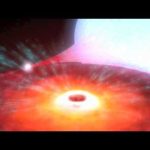Rendezvous with a Comet
From JPL. Comets are important because they represent the leftover bits and pieces from the outer solar system formation process, which took place four and a half billion years ago. As the planets formed, the first thing you got was tiny clumps of dust in the inner solar system, and in the outer system, dust and ice.
The comets are what made the cores of Jupiter, Saturn, Uranus and Neptune. But the planets are so hot that the chemistry changes completely, whereas the comets have remained frozen the entire time so that the chemistry is preserved. Comets are basically made up of a number of different regions; a dirty ice ball, relatively small and black. When it gets near the sun these ices start vaporizing, which forms a atmosphere. And then, when some of these dust particles are blown back away from the sun because of the pressure of sunlight, you form a dust tail and often a gas or ion tail.
Comets and asteroids have always gotten bad press. The dinosaurs checked out 65 million years ago because of an asteroid impact. But what we don’t hear about, is how important these objects are in terms of bringing the building blocks of life to the early planet. Comets almost certainly brought most of the organic material and much of the water to Earth.
In a sense, we wouldn’t even be here without comets and asteroids. Scientists like to put objects in boxes. Comets should look this way. Asteroids should look this way. But Mother Nature keeps knocking the boxes over and saying, no it doesn’t look that way. The few comets that we’ve seen, they all are very different from one another. So the question is, are all these objects different from one another? The Epoxi mission is an extended mission for the Deep Impact flyby spacecraft. After we went past comet Temple 1 and drove an impactor into it, we spent a year or more observing extrasolar planets and we are now on target for a flyby of comet Hartley 2. Which is interesting in the sense that it’s one of the smallest objects we’ve seen and it’s thought to be active over 100% of its surface. If we understand the comets really well, it will tell us how all the planets got made. That’s why we choose comets to study.
Leave A Reply
You must be logged in to post a comment.









 Paranormal
Paranormal

